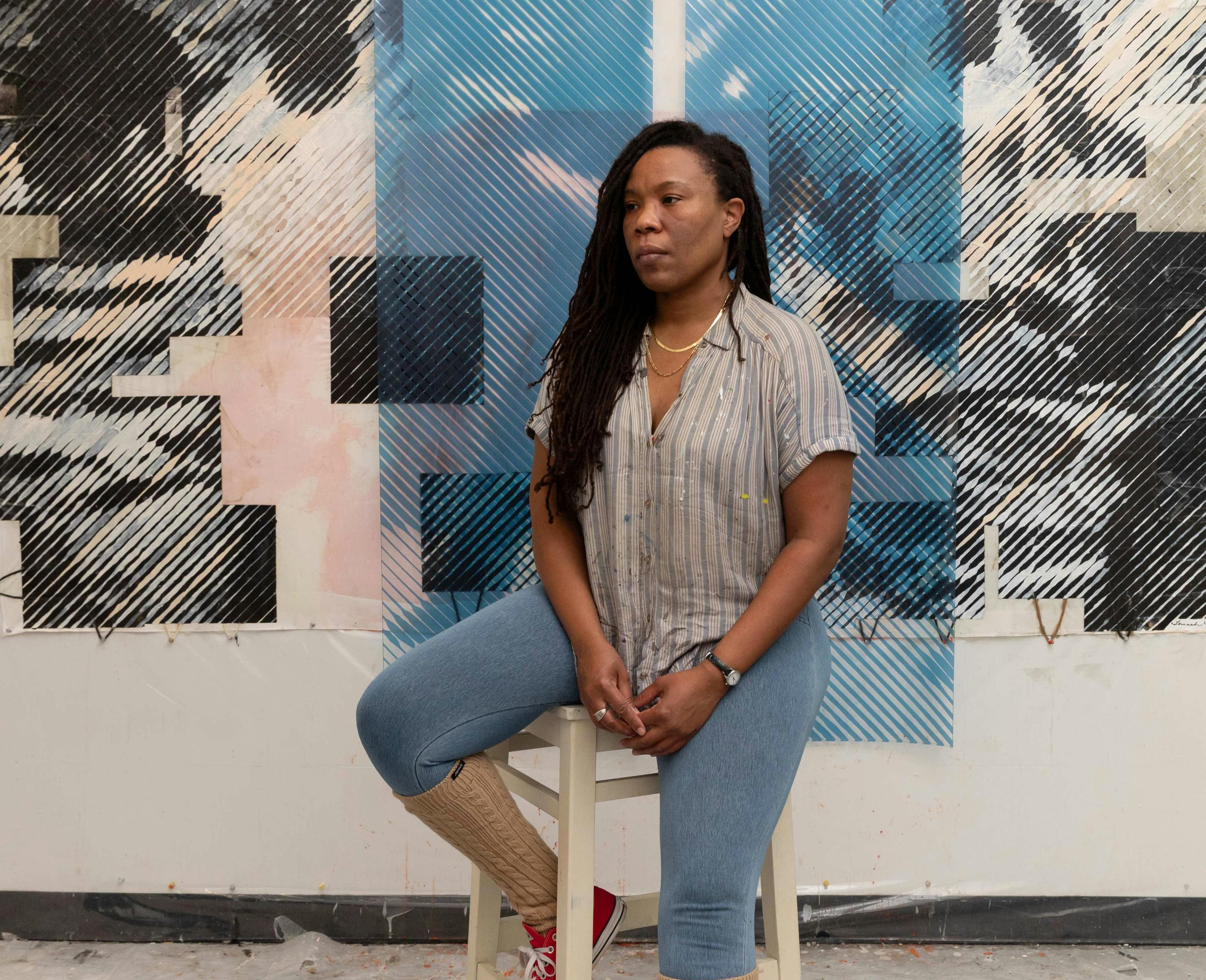Tomashi Jackson
(b. 1980)
Tomashi Jackson investigates the historical and current oppression of Black people impacted by displacement, migration, and labor.
Biography
Tomashi Jackson’s textured works interrogate, recontextualize, and revise mechanics of social power.
Growing up in Los Angeles, Jackson took photography classes with her mother. She studied her family photo albums, fostering her early thinking about lineage, growth, and visual connectivity. In her adolescence, she was greatly inspired by the murals that appeared throughout her home city. She enrolled at San Francisco Art Institute, but dropped out to work as an apprentice to muralist Juana Alicia. In 2005, Jackson moved to New York to attend Cooper Union, where she developed an interest in abstract expressionism. She then went on to study architecture at MIT, where, for her thesis, she collected oral histories on family and domestic labor. This project established an approach she maintains to this day of community-driven and conversation-based engagement with her subjects.
In 2014, while a volunteer with the Boston NAACP, Jackson came across Josef Albers’s theory of color perception. She noted that his description matched language related to racialized segregation found in court transcripts in the twentieth century, such as Brown v. Board of Education. She began to use notions of color and perception to explore not only racial politics but also abstraction, looking at contemporary instances of division and exclusion within public space. She has addressed topics such as Seneca Village, the experience of people of color living on Long Island’s East End, and voter suppression. Her multimedia works bring together painting, printmaking, textiles, embroidery, and photography. She employs different modes of hanging her works, such as the awning-style structures ubiquitous to urban businesses. Jackson draws and paints with “material that is ephemeral, tangible, and historic now, which feels right. I have looked to poetic structure to compose with my diverse palette in order to tell stories.”1
Jackson earned a BFA from Cooper Union, MS from MIT, and MFA from Yale School of Art. She also studied at the Skowhegan School of Painting and Sculpture. She received a Joan Mitchell Foundation Painters & Sculptors Grant (2020); and Roy R. Neuberger Prize from the Neuberger Museum of Art (2022). Her work entered the Studio Museum permanent collection in 2005.
1 “Rhythm and Blues: Tomashi Jackson by Cora Fisher,” BOMB, October 31, 2012, bombmagazine.org/articles/rhythm-and-blues-tomashi-jackson/.
Exhibitions and Events
Tomashi Jackson
(b. 1980)
Tomashi Jackson investigates the historical and current oppression of Black people impacted by displacement, migration, and labor.
John Brown's Body (Mr. Dorce in Red), 2019
Biography
Tomashi Jackson’s textured works interrogate, recontextualize, and revise mechanics of social power.
Growing up in Los Angeles, Jackson took photography classes with her mother. She studied her family photo albums, fostering her early thinking about lineage, growth, and visual connectivity. In her adolescence, she was greatly inspired by the murals that appeared throughout her home city. She enrolled at San Francisco Art Institute, but dropped out to work as an apprentice to muralist Juana Alicia. In 2005, Jackson moved to New York to attend Cooper Union, where she developed an interest in abstract expressionism. She then went on to study architecture at MIT, where, for her thesis, she collected oral histories on family and domestic labor. This project established an approach she maintains to this day of community-driven and conversation-based engagement with her subjects.
In 2014, while a volunteer with the Boston NAACP, Jackson came across Josef Albers’s theory of color perception. She noted that his description matched language related to racialized segregation found in court transcripts in the twentieth century, such as Brown v. Board of Education. She began to use notions of color and perception to explore not only racial politics but also abstraction, looking at contemporary instances of division and exclusion within public space. She has addressed topics such as Seneca Village, the experience of people of color living on Long Island’s East End, and voter suppression. Her multimedia works bring together painting, printmaking, textiles, embroidery, and photography. She employs different modes of hanging her works, such as the awning-style structures ubiquitous to urban businesses. Jackson draws and paints with “material that is ephemeral, tangible, and historic now, which feels right. I have looked to poetic structure to compose with my diverse palette in order to tell stories.”1
Jackson earned a BFA from Cooper Union, MS from MIT, and MFA from Yale School of Art. She also studied at the Skowhegan School of Painting and Sculpture. She received a Joan Mitchell Foundation Painters & Sculptors Grant (2020); and Roy R. Neuberger Prize from the Neuberger Museum of Art (2022). Her work entered the Studio Museum permanent collection in 2005.
1 “Rhythm and Blues: Tomashi Jackson by Cora Fisher,” BOMB, October 31, 2012, bombmagazine.org/articles/rhythm-and-blues-tomashi-jackson/.

